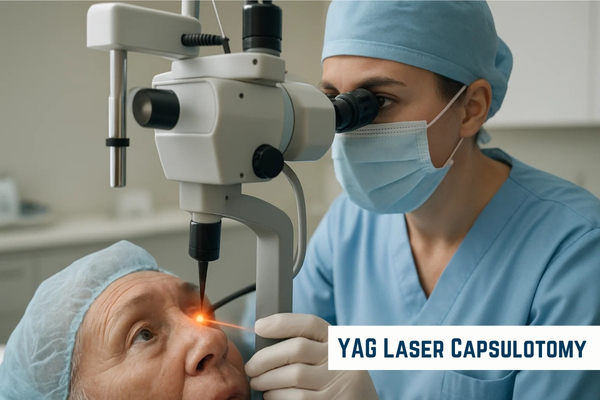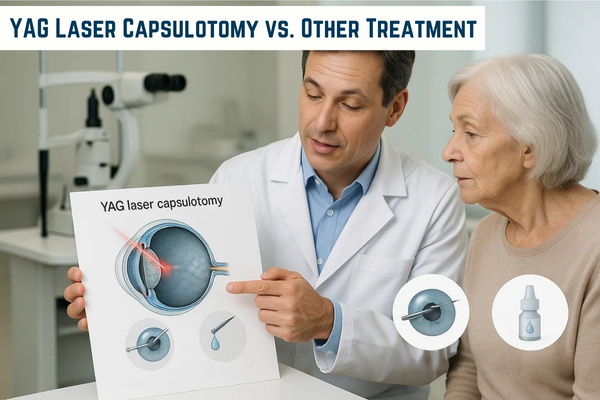Understanding YAG Laser Capsulotomy
YAG laser capsulotomy is primarily used to treat posterior capsular opacification (PCO), a complication that can occur after cataract surgery. When the posterior capsule of the eye becomes cloudy, it can obstruct clear vision, much like a cataract. Through a YAG laser eye treatment, the surgeon targets the cloudy area and creates a small opening to restore clarity.

How Does YAG Laser Capsulotomy Work?
A private YAG laser treatment is performed using a YAG laser to vaporize the cloudy posterior capsule. This process helps improve the passage of light into the retina, which enhances the patient’s vision. This procedure is usually quick and effective, performed in an outpatient setting with minimal discomfort.
How YAG Laser Capsulotomy Has Evolved?
Over the years, YAG laser has experienced significant improvements. Early treatments were less precise, which sometimes resulted in complications. With advancements in technology and techniques, the procedure has become safer and more efficient.
Technological Advancements in YAG Laser Machines
Modern YAG laser surgery machines offer more control over the laser’s intensity, duration and focus, improving both safety and effectiveness. With the ability to perform real-time imaging, ophthalmologists can now make better-informed decisions during the procedure, reducing risks and enhancing outcomes. These innovations have made YAG laser eye treatment more precise, ensuring greater accuracy in creating openings in the posterior capsule.
Improved Treatment Safety
Testimonials
“First Class Professional Care & Advice”
Enhanced Patient Comfort and Recovery
Advancements in YAG laser treatment techniques have contributed to quicker recovery times. The procedure is minimally invasive, requiring no stitches or cuts, which allows patients to recover faster with less discomfort. Today’s patients often report noticeable improvements in vision almost immediately following the treatment.
Why YAG Laser Capsulotomy is the Preferred Treatment Option?
There are several reasons why YAG laser capsulotomy is the preferred method for treating posterior capsular opacification (PCO) after cataract surgery. Its non-invasive nature and effectiveness make it an optimal choice for both patients and healthcare providers.
Minimally Invasive Nature of the Procedure
Unlike traditional surgery, YAG laser capsulotomy does not require any incisions. The procedure is performed with a laser beam that passes through the cornea, minimizing the risk of infection or other complications. This non-invasive nature makes it an attractive option for patients who are seeking a less invasive method to restore their vision after cataract surgery.
Quick and Effective Results
Patients who undergo YAG laser eye surgery often experience immediate improvements in their vision. Within hours of treatment, many individuals see reduced glare and enhanced clarity. This rapid restoration of sight is one of the key reasons YAG laser capsulotomy is so widely used in treating PCO.
Cost-Effective and Accessible
Compared to other surgical options, YAG laser surgery is relatively cost-effective. With the procedure’s growing availability in clinics and hospitals across the UK, it has become a highly accessible treatment option for patients experiencing PCO. Its affordability and efficiency contribute to its popularity.
When Should YAG Laser Capsulotomy Be Considered?
Client Speaks
“Extremely gentle, professional and informative, Could not wish for more “
Indications for YAG Laser Capsulotomy
Common signs that YAG laser eye treatment may be needed include blurry vision, glare and reduced contrast sensitivity. If these symptoms occur, it is important to consult an ophthalmologist to determine whether YAG laser capsulotomy treatment is necessary to restore clear vision.
How Soon After Cataract Surgery Can YAG Laser Capsulotomy Be Performed?
While the procedure can be performed shortly after cataract surgery, it is often recommended to wait until PCO becomes noticeable. In some cases, however, YAG laser treatment may be used within a few months of cataract surgery to prevent further vision decline.
YAG Laser Capsulotomy vs. Other Treatment Options
While YAG laser capsulotomy is the most common method for treating PCO, other treatment options are available. These alternatives may be considered based on individual circumstances.

Traditional Cataract Surgery
Cataract surgery involves removing the clouded lens and replacing it with an artificial lens. However, PCO can develop over time, leading to the need for YAG laser capsulotomy. While traditional surgery addresses the cataract itself, YAG laser eye treatment is often required afterward to address complications like PCO.
Intraocular Lens Exchange
In rare cases, patients may require an intraocular lens (IOL) exchange if the lens becomes dislocated or damaged. However, this is a more invasive procedure compared to YAG laser surgery, which is why most patients with PCO will benefit from YAG laser treatment instead.
Conclusion
The evolution of YAG laser capsulotomy has been nothing short of remarkable. Over the years, technological advancements have improved the precision, safety and effectiveness of the procedure, making it an ideal treatment for those experiencing posterior capsular opacification after cataract surgery. As the technology continues to advance, YAG laser capsulotomy treatment will undoubtedly continue to improve, providing patients with better outcomes and faster recovery times.
If you or someone you know is experiencing vision problems following cataract surgery, YAG laser capsulotomy could be the solution. Contact us today to learn more about how this cutting-edge procedure can restore vision and improve quality of life.
Frequently Asked Questions - YAG Laser Capsulotomy
Q1. What is YAG laser capsulotomy?
A. YAG laser capsulotomy is a procedure used to treat posterior capsular opacification (PCO) after cataract surgery. The laser creates a small opening in the cloudy capsule to restore clear vision.
Q2. Is YAG laser capsulotomy safe?
A. Yes, YAG laser treatment is safe. Modern techniques and advanced laser systems significantly reduce the risks associated with the procedure.
Q3. How soon will I see results after YAG laser surgery?
A. Most patients notice an immediate improvement in their vision following YAG laser eye treatment. The procedure is quick and typically results in enhanced clarity and reduced glare.
Q4. How long does it take to recover from YAG laser capsulotomy?
A. The recovery time is minimal. Most patients can resume normal activities within a day or two after YAG laser capsulotomy treatment.
Q5. Can YAG laser capsulotomy be performed on both eyes?
A. Yes, YAG laser capsulotomy can be performed on both eyes, but usually, one eye is treated at a time to monitor recovery and outcomes.
